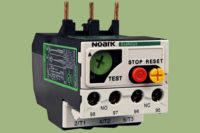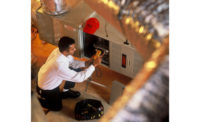Components commonly packaged in electrical enclosures, computer server racks, and other product compartments are the vital controls for drives and displays used in many industries, including: HVAC, industrial automation, telecommunications, food and beverage manufacturing equipment, steel manufacturing and forming, security imaging and detection equipment, and more.
The primary purpose of these electrical enclosures is to provide protection and safety for the components they house. If an enclosure is properly cooled, the components within can have a long and useful life. Without proper cooling, however, the components in these enclosures can be subject to damaging heat, shortening their longevity and reliability.
Although individual manufacturer’s specifications vary, most electrical equipment is designed to operate properly and achieve normal life expectancy under ambient air conditions ranging from 40°-50°C (104°-122°F). Table 1 indicates the maximum operating temperatures for specific devices. (It is generally accepted that operating temperatures above this range reduce life expectancy: Every 10° rise in temperature shortens the average reliability of electrical/electronic components by 50 percent.) Table 1 provides examples of components typically found in electrical enclosures.
Based on the information provided in Table 1, it is clear that thermal management is advantageous. Reducing the operating temperatures within electrical enclosures is an effective way to increase life expectancy and system reliability. If an enclosure is properly cooled, the cost associated with that cooling can be recovered over the life of the equipment. Chart 1, “Drive Life Increase with Reduction of Enclosure Temperature,” illustrates the benefits of increased longevity when a drive enclosure is cooled properly. This is based on typical drives having a 40°C (104°F) maximum recommended environmental temperature.
The Sources of Heat
The primary source of heat production in an electrical enclosure is from the working components. Devices that transmit motive power have voltage drop or efficiency losses that are converted into heat. In the case of electronics or microprocessors, nearly all of their power is converted into heat. The means for calculating and estimating this heat generation are available from enclosure cooling manufacturers in the form of spreadsheets or calculators. Heat gain or loss is expressed in watts or Btu (British Thermal Units). These units of heat are converted as follows: Watts = Btuh ÷ 3.414 and Btuh = Watts x 3.414.
This internal heat load is one source that will cause the internal enclosure temperature to rise to unacceptable levels if it is not removed.
• Ambient air
Ambient air, which is the air outside the enclosure, can also be a potential source of heat gain. The ambient air may be cool enough to allow the enclosure to dissipate heat; however, in many cases ambient air may be so hot that it adds to the heat load.
• Solar load
When enclosures located outdoors are exposed to the sun, heat will be transferred to the inside of the enclosure. This is known as solar load or solar gain. (The effects of solar load can be significant; an automobile parked outdoors on a sunny day is a prime example.) Thermal insulation, white reflective paint finishes, and a roof or sunshield will often help to offset solar load. Some enclosures are double walled for this purpose; however, this tends to be a very costly process.
• Humidity and air infiltration
Outside air entering an electrical enclosure carries both heat and humidity. High relative humidity in the air potentially increases the heat content; in most cases it is best to seal the enclosure to limit this effect. Condensing water vapor or the formation of dew from high humidity, particularly in outdoor enclosures, will damage the electrical and electronic contents of an enclosure. It is best to seal up enclosures and feeding conduits completely to avoid this type of heat gain and effects of humidity.
Removing the Heat
Heat transfer by natural convection is the simplest and most common method of cooling electronics. Relying entirely on hot air rising, however, is generally not sufficient to safely cool sensitive electronics and electrical power transmitting components. Often natural convection is used in conjunction with a heat sink to keep electronics cool. An electronic component mounted on a heat sink helps cool the electronics by dissipating heat into the air. Such passive thermal management solutions are found in consumer electronics, appliances, and systems where enclosures or compartments are not subject to sufficient heat gain to cause a significant heat build-up. Environmental testing is performed for agency listed products and mass produced products to be sure passive heat dissipation will be effective.
Blowers, Fans, Motorized Impellers, and Fan Trays
Blowers, fans, motorized impellers and fan trays are open loop cooling systems that can be used when the surrounding air can be passed over the heat producing components and exhausted from the enclosure. Fans usually have some type of air filtration; even applications in the cleanest environments should have minimal protection from drawing airborne particulate into the enclosure. Packaged blowers can be used in enclosures to cool in high static pressure conditions, and motorized impellers as well as fan trays can be used to cool hotspots either alone or in conjunction with other cooling systems.
There are two airflow options when open loop cooling is used on an enclosure: one is to pressurize the enclosure, and the other is to vacuumize. Of the two options, pressurizing is preferred because it will utilize all louvers, cracks, and openings as part of the exhaust flow, rather than pulling air and possibly dirt in through them.
Open loop systems are limited in that they can only cool to a certain point above the ambient temperature. In applications where the ambient temperature is too high, or the airflow necessary to provide the required amount of cooling becomes too high, an air conditioner, water to air heat exchanger or air to air heat exchanger is necessary.
Heat Exchangers
Air to air heat exchangers utilize closed loop cooling. A closed loop system will cool an enclosure without introducing outside air, which may be too hot or dirty. Heat exchangers are a good choice when it is necessary to remove heat from an enclosure while keeping ambient air out. Air to air heat exchangers operate by means of two separate airflows which pass through a convoluted metal foil element. Enclosure heat is transferred from one side to the other through the element and exhausted to the outside. Heat exchangers have a lower initial cost and are generally less expensive to maintain than air conditioners. However, heat exchangers share the same limitations as open loop cooling systems.
Water to air heat exchangers provide cooling in a closed loop system where a reliable source of clean, cool or chilled water is available. Models are available that are designed primarily for use in harsh environments and feature cooling capacities in excess of air to air heat exchangers. They are particularly useful in highly contaminated environments that would require frequent cleaning or changing of ambient air filters or frequent cleaning of the heat exchanger core. Water to air heat exchangers provide greater heat transfer performance than air to air heat exchangers, in a compact package.
Air Conditioners
Special purpose air conditioners are recommended where high heat transfer and closed loop cooling are required. Unlike their comfort cooling counterparts, special purpose air conditioners are closed loop systems designed for use in higher ambient conditions. Typical air conditioners have refrigerant charged compressors that are controlled by a thermostat to limit electrical enclosure temperatures while saving energy between cycles. Initial investment and operating costs are higher than those of the cooling systems mentioned above.
Air conditioners should be sized for a maximum allowable temperature from which the Btuh is determined. The maximum enclosure air temperature should be limited to the lowest maximum operating temperature for each specific device. Typically the most susceptible devices are variable frequency drives and computers.
System Design and Economic Considerations
• Avoiding condensation
In order to avoid a build-up of condensation, internal heaters are an important accessory to consider when designing a cooling system for an application. In outdoor applications, during the night or off-peak hours, the internal enclosure temperature may drop below the dew point. This causes condensation to accumulate on sensitive electronics and electrical contact surfaces, leading to corrosion and ultimate failure. To prevent this problem, an internal heater should be used to maintain the temperature of the enclosure. Heaters are commonly incorporated into air conditioners and are also available as individual devices.
• NEMA enclosure ratings
National Electrical Manufacturers Association (NEMA) enclosure ratings are placed on enclosure cooling units and electrical enclosures to designate the environmental hazard from which the contents are being protected. NEMA defines the standards for different levels of protection of electronics enclosures. Typical examples of NEMA ratings include: NEMA 12 for indoor use, protection from dust and dripping liquids; NEMA 3R for outdoor use and rain-proof applications; and NEMA 4X for indoor/outdoor use to provide protection from wash-down and corrosive environments. The NEMA rating on an air conditioner should be matched to the NEMA rating on an enclosure being cooled.
• Investment in enclosure cooling yields high return
The installation costs of an enclosure housing a variable frequency drive and associated controls, together with the cooling system designed to cool the application can range from under $50,000 to over $100,000. This application could be part of a manufacturing process or service generating considerable revenues. The cost of installing an enclosure cooling system designed for a specific application is very low when compared to the cost of the overall system, ranging from 2 percent to 4 percent of the entire equipment cost. This low cost percentage per application is also true of other common applications.
The economic and safety related consequences of improper heat dissipation for systems used in critical infrastructure as well as other possible service interruptions should be considered at the design stage. Lost revenue due to heat related failures can quickly justify the expense for enclosure cooling.
It is important to think about cooling in the early stages of the design process, whether designing a new system or retrofitting an existing system. If you configure the enclosure to run cool and dry from the beginning, you’ll see reliable system operation and avoid the cost and frustration of system failure.
For more information, visit www.kooltronic.com.
Publication date: 1/7/2013











